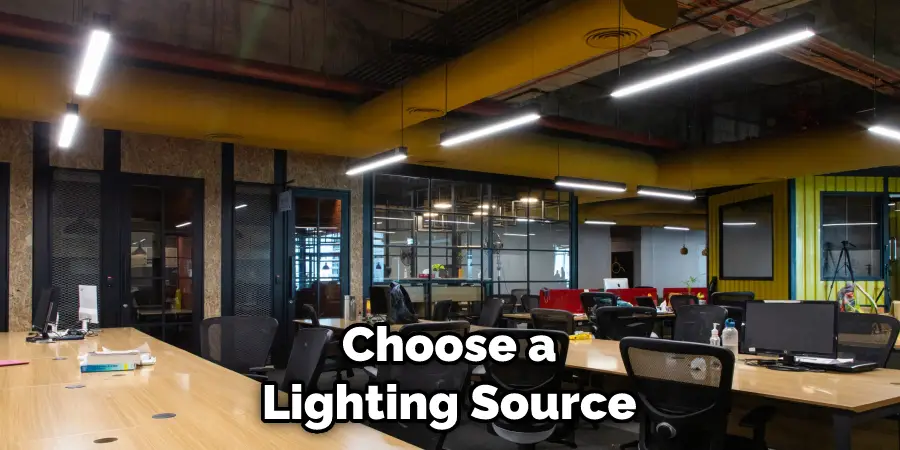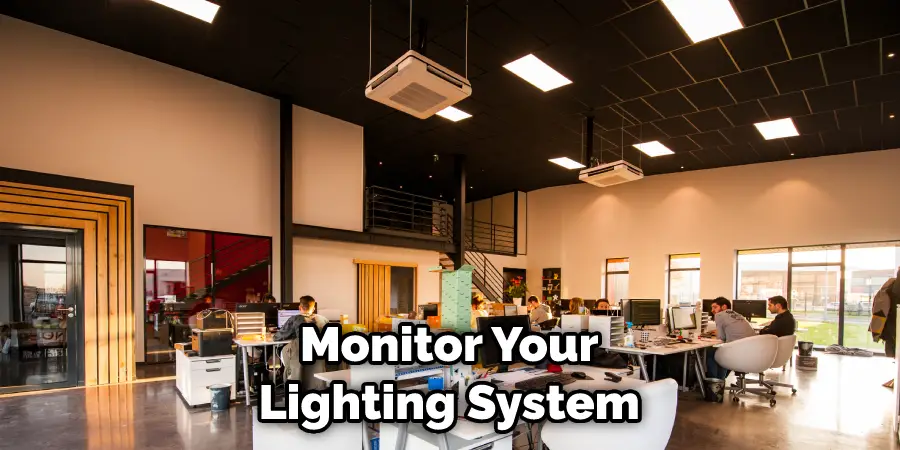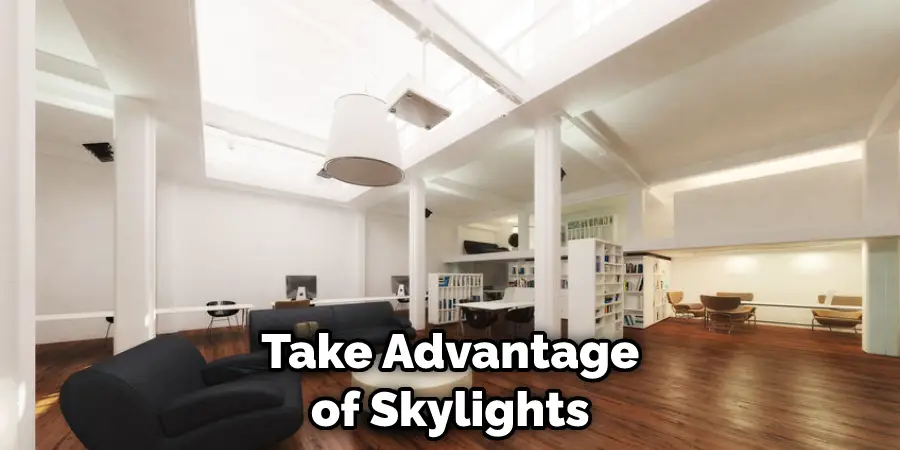We all know how important natural light is for our overall well-being. Natural light helps us feel energized and productive, boosts our mood, and even helps with vision health.

But for many offices, access to direct sunlight is impossible. That’s why it’s important to know to simulate natural light in an office environment. Simulating natural light in an office environment can provide many advantages.
One of the primary benefits of using simulated natural light is improved health and well-being. Studies have shown that people exposed to more natural light are less likely to suffer from seasonal depression, fatigue, insomnia, and stress-related illnesses.
Natural light also helps regulate hormones related to sleep and wakefulness, which can improve alertness and energy levels. In this blog post, You will learn in detail how to simulate natural light in an office.
Step-by-Step Processes for How to Simulate Natural Light in an Office
Step 1: Inspect the Room
Before you can simulate natural light in an office, it is important to identify the source of your current lighting and understand how much additional lighting will be needed. Check for windows and existing lights that could be used to provide more light, such as floor lamps or desk lamps.
Step 2: Assess Your Lighting Needs
Once you have identified the source of your current lighting, assess how much additional light you will need in order to simulate natural light. This may depend on the size of the room and the number of occupants.
Choose a lighting source that best suits your needs, such as LED or fluorescent bulbs. Consider factors such as energy efficiency and cost when selecting a light source.

Step 3: Install Your Lighting Fixtures
Once you have selected your lighting source, it is time to install the fixtures. Make sure to follow the manufacturer’s instructions for proper installation. Consider whether you will need special wiring or any other professional help.
Choose a color temperature that best replicates natural light. Warmer colors, such as those from incandescent bulbs, will have yellowish tones, while cooler colors, such as those from LED or fluorescent bulbs, will have more blueish hues.
Step 4: Increase the Brightness of Your Lights
Make sure your lights are bright enough to simulate natural light. You may need to increase the wattage or add additional lighting fixtures to achieve the desired brightness level. Choose a light color that will complement your office decor and create an atmosphere that simulates natural light. For example, if you have earth-tone colors in your office, consider choosing a light with warmer tones.
Step 5: Place Your Lighting Strategically
Choose the best location for your lighting fixtures to ensure that they are able to provide maximum illumination throughout the room. Consider placing lamps on tables and floor lamps near the corners of the room.
Utilize daylight harvesting techniques to maximize the amount of natural light in your office space. Consider investing in window treatments like blinds or shades that can open and close depending on the time of day.
Step 6: Monitor Your Lighting System Regularly
Finally, monitor your lighting system regularly to ensure that it works properly and provides optimal illumination. Make sure to replace bulbs when necessary and check for any damage or signs of wear and tear.

By following these steps, you’ll be able to simulate natural light in your office space and create a bright, inviting atmosphere. With the right lighting, you’ll be able to improve productivity and create a more pleasant work environment.
Tips for How to Simulate Natural Light in an Office
- Avoid using direct sunlight when simulating natural light in the office. While natural sunlight is great for providing lighting, it can be damaging if exposed directly to people and objects over an extended period of time.
- Don’t forget about glare control! Make sure that your office space contains blinds or curtains that can be adjusted to filter out the sunlight depending on its intensity. This will prevent any uncomfortable glare for your employees and reduce the risk of eye strain.
- Utilize natural light-simulating light bulbs when necessary. It is not always cost-effective or practical to utilize windows as a source of simulated natural light, so make sure that you are using light bulbs that can replicate natural sunlight as closely as possible.
- Make sure to incorporate an adjustable lighting system. This will allow employees to customize the brightness and color temperature of the lights in their workspace, helping them simulate natural light throughout various times of day or seasons.
- Use task-specific lamps when appropriate. Sometimes, finding the perfect balance between natural and artificial light is hard. Investing in task-specific lamps such as desk lamps or floor lamps can supplement the lighting provided by your office’s windows or natural light-simulating bulbs.
- Consider using daylight harvesting systems when possible. Daylight harvesting systems are automated systems that detect the amount of natural light available and adjust the artificial lighting accordingly. This can help reduce energy costs while improving your office’s lighting quality.
Following these tips will help you create a more pleasant work environment that uses the best of both worlds.
Are There Any Special Considerations When Using Artificial Light to Simulate Natural Light?
When using artificial light to simulate natural light in an office, you should keep a few things in mind. It’s important to understand that the different lighting types can affect how people feel and their productivity levels.
For example, cool white fluorescent lighting may cause eye strain or drowsiness in some people, while warm yellow incandescent lighting may make people feel more relaxed and comfortable.

Additionally, if you’re using halogen bulbs or any other type of artificial light that generates a lot of heat, it’s important to ensure the room is well-ventilated to avoid overheating.
Since natural sunlight varies throughout the day, it’s also important to adjust your artificial lighting throughout the day. A good way to do this is to use a light control system that can be programmed to change according to daylight hours.
This will help make your office environment more natural and comfortable for everyone. Finally, when selecting lighting fixtures for an office, it’s important to consider how they will look in the room. Certain fixtures may take away from the aesthetics of a space and make it feel less natural.
What is the Best Way to Make Sure Natural Light is Used Effectively in an Office?
Using natural light in an office environment is a great way to create an inviting atmosphere, reduce energy costs, and even improve employee productivity. Here are some tips for using natural light in an office:
- Choose furniture and decor that will maximize the available light. For example, use lighter colors on the walls and furniture to reflect more natural light into the room.
- Install solar shades or curtains that can be adjusted to regulate the amount of natural light entering the office. This will help reduce glare and heat transfer while still allowing in plenty of natural light.
- Take advantage of skylights and windows to maximize the light coming into the office. Consider how you can use them strategically to make the most of natural light.
- Utilize task lighting to supplement any areas that lack sufficient natural light. Task lighting is a great way to provide more focused, adjustable light for tasks requiring higher levels of illumination, such as reading or writing.
- Take advantage of advances in lighting technology to simulate natural light and provide an even more inviting atmosphere. Many LED lights now come with adjustable settings that can mimic the light from sunrise to sunset, helping to encourage a productive working environment throughout the day.

By following these tips, you can create an office space that is well-lit, inviting, and conducive to productivity. Natural light can help create a comfortable working environment by reducing glare, heat transfer, and electric costs while promoting better concentration and focus for employees.
What Kind of Maintenance is Necessary to Ensure Natural Light Sources Are Used Effectively in an Office?
Regular maintenance needs to be done to ensure that natural light sources are used effectively in an office. If a window has dirt or dust buildup, then it should be cleaned, and the glass should be wiped down.
Additionally, any curtained windows should regularly wash their curtains to keep them from blocking out the natural light. It is also important to ensure that windows are free from obstructions such as furniture or plants, which could prevent natural light from entering the room.
Finally, any blinds or shades should be checked and adjusted to make sure they are not blocking out too much or too little of the natural light. By following regular maintenance routines, it is possible to take full advantage of the natural light available in an office setting.
This will provide a pleasant and comfortable work environment while also saving energy costs associated with artificial lighting.
How Can the Use of Natural Light Be Beneficial for the Health and Well-Being of Office Staff?

Using natural light in an office environment has been linked to improved mental and physical health, morale and productivity of staff, and better concentration.
Studies have shown that natural lighting can reduce tiredness and fatigue throughout the day while also improving alertness, moods, and overall well-being. Additionally, exposure to natural light helps regulate circadian rhythms, which are vital for proper sleep.
When natural light is used in an office setting, staff can experience improved focus and productivity and increased creativity. The use of artificial lighting often causes visual fatigue and glare when compared to natural lighting.
Glares can cause discomfort and eye strain throughout the day, which leads to poorer mental performance. Natural lighting can also help reduce the risk of headaches, migraines, and other health issues.
Are There Any Environmental Benefits Associated With Using Natural Light in an Office Environment?
Yes. Electronic lighting is one of the biggest energy consumers in office spaces. Up to 40% of a building’s electricity consumption is estimated to be attributed to lighting alone.
Simulating natural light in an office through various strategies can significantly reduce the amount of energy used for electronic lighting and, thus, lower environmental impact. Aside from energy savings, simulating natural light can also have positive impacts on occupant health and well-being.
Studies have found that natural light helps to improve sleep patterns, reduce depression and stress levels, increase productivity, and even prevent vision loss.
Ultimately, simulating natural light in an office environment offers numerous environmental benefits, such as reduced electricity use, improved health and well-being, and fewer workplace distractions due to the reduced need for artificial lighting.
So if you’re looking to create a more sustainable office environment, simulating natural light is an excellent option that can give you the best of both worlds.
Conclusion
In conclusion, simulating natural light in an office is a great way to create a brighter, more comfortable work environment. It can be done with the help of strategically placed mirrors, LED lights, and other lighting technologies that mimic the effects of sunlight.
Additionally, using sheer curtains or blinds to let in natural light from the outside can also be beneficial. Taking proactive steps to bring more natural light into your office space can increase productivity and morale while also reducing stress levels.
I hope this article has been beneficial for learning how to simulate natural light in an office. Make Sure the precautionary measures are followed chronologically.
You Can Check It Out Maximize Desk Space With Multiple Monitors

